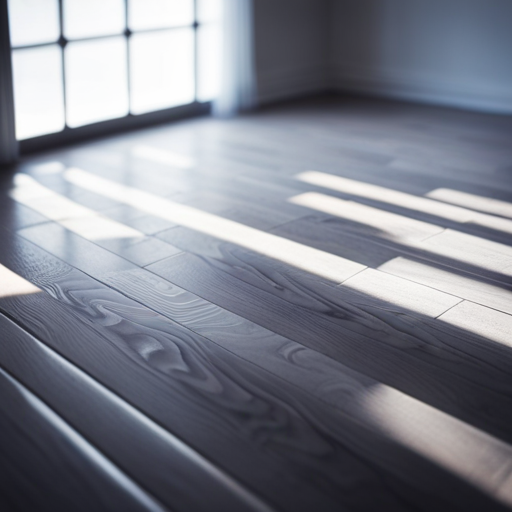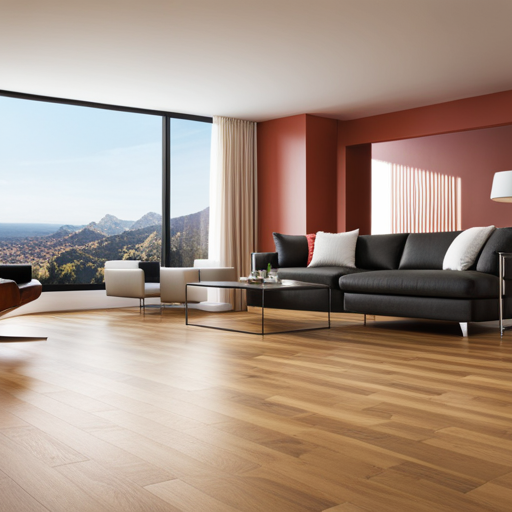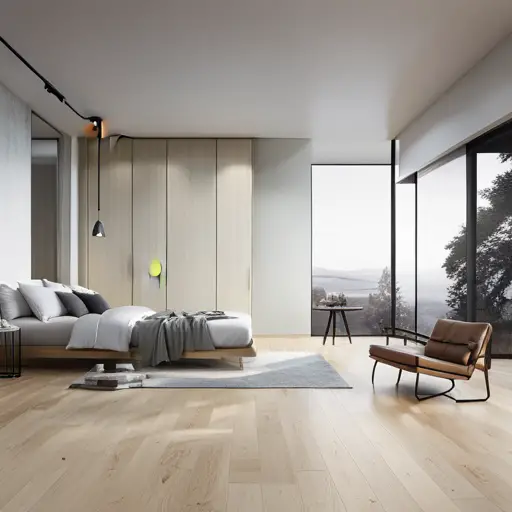Flooring for High-Moisture Environments

In the world of flooring, high-moisture environments can be likened to turbulent seas, requiring sturdy vessels to navigate their challenges.
This article delves into the realm of waterproof vinyl, porcelain, and ceramic tiles, as well as epoxy and rubber flooring, engineered hardwood, and concrete options.
Each offers a unique blend of resilience and aesthetics, ensuring a secure and stylish foundation in the face of moisture’s relentless tides.
Waterproof Vinyl Flooring
When considering flooring options for high-moisture environments, waterproof vinyl flooring is an excellent choice due to its durability and resistance to water damage. Installation methods for waterproof vinyl flooring vary, with options for click-lock, glue-down, or loose lay, providing flexibility based on the specific needs of the space. Maintenance requirements are minimal, requiring only regular sweeping and occasional mopping to keep the floors looking their best.
Cost comparison between waterproof vinyl flooring and other high-moisture flooring options often favors vinyl due to its relatively lower cost per square foot, making it an attractive choice for budget-conscious projects. Additionally, the environmental impact of vinyl flooring has improved over the years, with many manufacturers offering eco-friendly options that use recycled materials and have low volatile organic compound (VOC) emissions.
Transitioning into the subsequent section about ‘porcelain tile’, it is important to note that while waterproof vinyl flooring offers many benefits, porcelain tile provides a different set of advantages for high-moisture environments.
Porcelain Tile
Porcelain tile is a popular choice for high-moisture environments due to its durability and resistance to water. It is known for its ability to withstand wet conditions without deteriorating, making it an ideal option for bathrooms, kitchens, and other areas prone to moisture.
Additionally, porcelain tile is easy to clean, providing a low-maintenance flooring solution for areas with high humidity or moisture.
Durability in Wet Areas
The durability of porcelain tile in wet areas is a crucial consideration for high-moisture environments. Porcelain tile is highly durable and can withstand the challenges posed by wet areas, making it an ideal choice for such environments. Its low maintenance requirements further enhance its suitability for high-moisture areas.
Porcelain tile is resistant to water, stains, and wear, making it an excellent option for areas prone to moisture and frequent cleaning. Its durability ensures that it can withstand the rigors of wet environments without deteriorating or requiring frequent repairs. This makes it a cost-effective and long-lasting flooring solution for spaces with high moisture levels.
Transitioning into the subsequent section, the ease of cleaning porcelain tile further adds to its appeal in high-moisture environments.
Easy to Clean
In high-moisture environments, maintaining cleanliness becomes crucial for preserving the integrity of porcelain tile flooring. Porcelain tile is known for its resistance to moisture, making it a popular choice for areas prone to high humidity. To ensure the longevity and pristine appearance of porcelain tile flooring, the following maintenance tips and best practices are recommended:
- Regularly sweep or vacuum the floor to remove dirt and debris.
- Clean the tile surface with a mild detergent and water solution, using a soft mop or cloth.
- For stubborn stains, utilize a non-abrasive cleaner specifically designed for porcelain tile.
By adhering to these maintenance tips and best practices, the cleanliness and luster of porcelain tile flooring can be easily maintained, ensuring its long-term durability and aesthetic appeal.
Transitioning into the subsequent section about ‘epoxy flooring’, it’s important to consider alternative options for high-moisture environments.
Epoxy Flooring
One option for high-moisture environments is to consider using epoxy flooring. Epoxy flooring is a popular choice due to its exceptional chemical resistance, making it highly suitable for environments where moisture and chemical exposure are prevalent. This type of flooring is commonly used in industrial applications where the potential for spills and exposure to harsh chemicals is high.
Epoxy flooring’s superior chemical resistance is attributed to its seamless and impermeable surface, which forms a protective barrier against moisture and chemical penetration. As a result, it effectively safeguards the underlying concrete substrate from moisture-related damage and chemical corrosion.
In addition to its resistance to moisture and chemicals, epoxy flooring is also known for its durability, impact resistance, and low maintenance requirements, making it an ideal flooring solution for high-moisture environments in industrial settings.
Engineered Hardwood
An engineered hardwood flooring solution is designed to withstand high-moisture environments while providing a durable and aesthetically pleasing option for various settings. This type of flooring is constructed by binding layers of real wood together with adhesives, making it more resistant to moisture and temperature variations compared to traditional hardwood.
When considering engineered hardwood for high-moisture environments, there are several key factors to take into account:
-
Moisture Resistance: Engineered hardwood is designed to resist expansion and contraction caused by changes in moisture levels, making it an ideal choice for environments prone to high humidity or moisture.
-
Durability: Its layered construction provides enhanced stability and durability, ensuring the flooring maintains its structural integrity even in high-moisture conditions.
-
Installation Process: The installation process for engineered hardwood is crucial for its performance in high-moisture environments. Proper acclimation and moisture barriers are essential to prevent moisture-related issues in the long term.
Regarding long-term maintenance, engineered hardwood requires regular cleaning and maintenance to preserve its quality and appearance, especially in high-moisture environments.
Transitioning to the subsequent section about ‘concrete flooring’, it is essential to understand its suitability and advantages in similar environmental conditions.
Concrete Flooring
The durability and moisture resistance of engineered hardwood make it a suitable choice for high-moisture environments. Transitioning to the discussion of concrete flooring, its advantages in similar conditions become apparent.
Concrete flooring is highly durable and well-suited for high-moisture environments such as basements and industrial spaces. One of the key advantages of concrete flooring is its low maintenance requirements. Regular sweeping and occasional mopping are usually sufficient to keep it clean. Additionally, sealing concrete floors can further enhance their moisture resistance, making them even more suitable for high-moisture environments.
When it comes to installation, concrete flooring offers various techniques including pouring, stamping, staining, or polishing, providing versatility in achieving the desired aesthetic and functionality. Proper installation is crucial for ensuring the longevity and performance of concrete floors in high-moisture environments. Therefore, it is essential to engage professionals with expertise in concrete flooring installation techniques.
As we explore concrete flooring’s attributes, it becomes evident that its resilience and adaptability make it a compelling choice for high-moisture environments. Transitioning to the subsequent section about ‘ceramic tile’, we can further explore alternative flooring options for such conditions.
Ceramic Tile
Transitioning from concrete flooring to ceramic tile, the durability and water-resistant properties of ceramic make it a promising choice for high-moisture environments. Ceramic tiles are an excellent option due to their ability to withstand moisture, making them ideal for areas such as bathrooms, kitchens, and laundry rooms.
The design options available with ceramic tiles are vast, allowing for versatility in creating the desired aesthetic. From traditional to modern designs, ceramic tiles offer a wide range of colors, patterns, and textures, providing ample choices to suit different preferences and styles.
When it comes to grout maintenance, it is essential to ensure that the grout lines are properly sealed to prevent moisture from seeping through. Regular cleaning and sealing of grout are crucial to maintain the integrity of the ceramic tile installation and prevent water damage. The ease of maintenance and cleaning further adds to the appeal of ceramic tile in high-moisture environments.
- Durability and water resistance make ceramic tiles suitable for high-moisture environments.
- Ceramic tiles offer a wide range of design options to cater to various styles.
- Proper grout maintenance, including sealing and cleaning, is essential for preserving the integrity of ceramic tile installations.
Rubber Flooring
Rubber flooring is a popular choice for high-moisture environments due to its durability and resistance to water damage.
In addition to being easy to clean, rubber flooring provides a slip-resistant surface, making it a safe option for areas prone to moisture.
These key points make rubber flooring a practical and reliable solution for spaces where moisture is a concern.
Durability in Moisture
When considering flooring options for high-moisture environments, it is essential to prioritize durability, especially in the case of rubber flooring. Rubber flooring stands out for its exceptional moisture resistance and long-term performance, making it a top choice for areas prone to high humidity or occasional water exposure.
Here are three key reasons why rubber flooring demonstrates remarkable durability in moisture-prone settings:
-
Waterproof Properties: Rubber flooring is inherently resistant to water, preventing moisture from seeping through and causing damage to the subfloor.
-
Mold and Mildew Resistance: Its non-porous surface inhibits the growth of mold and mildew, ensuring a hygienic environment and prolonging the flooring’s lifespan.
-
Stability in High Humidity: Rubber flooring remains stable and resilient even in high-humidity conditions, making it a reliable option for long-term use in moisture-rich areas.
Easy to Clean
With its exceptional moisture resistance and long-term performance, rubber flooring is remarkably easy to clean, making it a top choice for high-moisture environments.
Proper maintenance is essential for preserving the quality and longevity of rubber flooring. Regular maintenance tips include sweeping or vacuuming to remove dirt and debris, as well as promptly wiping up spills to prevent staining.
For routine cleaning, a mild detergent and water solution can be used to mop the floor, followed by thorough rinsing and drying. For tougher stains or dirt buildup, a soft-bristle brush or a buffing machine can be employed.
It’s important to avoid using harsh chemicals or abrasive tools that can damage the rubber surface. By following these cleaning techniques and maintenance tips, rubber flooring can maintain its durability and aesthetic appeal in high-moisture environments.
Slip-Resistant Surface
In high-moisture environments, the slip-resistant surface of rubber flooring provides an essential safeguard against potential accidents. This type of flooring is designed to offer stability and traction, making it an ideal choice for areas prone to moisture and spills.
Here are some key points to consider when it comes to safety standards and maintenance tips for slip-resistant rubber flooring:
-
Safety Standards: Ensure that the rubber flooring meets industry safety standards for slip resistance to minimize the risk of slips and falls, especially in high-moisture areas.
-
Regular Cleaning: Implement a regular cleaning routine using mild detergents and non-abrasive cleaning tools to maintain the slip-resistant properties of the rubber flooring.
-
Periodic Inspections: Conduct regular inspections to identify any signs of wear or damage, and promptly address any issues to uphold the flooring’s slip-resistant surface.
Laminate Flooring
Laminate flooring has proven to be a durable and cost-effective solution for high-moisture environments over the past decade. The installation process for laminate flooring is relatively straightforward, often involving a simple click-and-lock mechanism, which makes it an attractive option for those seeking to reduce installation costs. In terms of cost comparison, laminate flooring is generally more budget-friendly than hardwood or stone flooring, making it an appealing choice for high-moisture environments where traditional materials may be impractical.
Regarding maintenance requirements, laminate flooring is easy to clean and maintain, requiring only regular sweeping and occasional damp mopping. This low-maintenance feature is advantageous in high-moisture environments where moisture-related issues are a concern.
In addition, laminate flooring has a minimal environmental impact compared to other flooring materials, as it can be produced using sustainable materials and does not deplete natural wood resources. Its durability and resistance to moisture make it a sustainable choice for high-moisture environments, providing both longevity and environmental consciousness.
Frequently Asked Questions
Can I Use Laminate Flooring in a High-Moisture Environment?
Laminate flooring is not recommended for high-moisture environments due to its limited moisture resistance. While it offers durability, prolonged exposure to moisture can cause warping and damage. Consider moisture-resistant options like vinyl or porcelain tile instead.
What Are the Maintenance Requirements for Rubber Flooring in High-Moisture Areas?
Managing rubber flooring in high-moisture areas demands meticulous maintenance. Regularly inspecting for water damage, employing proper cleaning techniques, and controlling humidity levels are crucial. Special considerations for concrete subfloors and epoxy flooring must be prioritized.
Is Engineered Hardwood Suitable for Areas With Fluctuating Humidity Levels?
Engineered hardwood is suitable for areas with fluctuating humidity levels due to its moisture resistance. Unlike laminate flooring, engineered hardwood is less prone to water damage, making it a viable option for high-moisture environments.
Can Porcelain Tile Be Installed Directly Over a Concrete Subfloor in a High-Moisture Environment?
When installing porcelain tile over a concrete subfloor in high-moisture environments, ensure proper subfloor preparation, moisture testing, and the use of a moisture barrier. Direct installation of porcelain tile offers excellent moisture resistance and durability.
Are There Any Special Considerations for Installing Epoxy Flooring in a High-Moisture Environment?
When installing vinyl flooring in high-moisture environments, it’s crucial to prioritize moisture resistance. However, it’s important to note that epoxy flooring has limitations in high-moisture areas. Special considerations should be made to ensure proper installation.
Conclusion
In conclusion, when it comes to flooring for high-moisture environments, there are numerous options available that are durable and water-resistant.
From waterproof vinyl and porcelain tile to epoxy and rubber flooring, the choices are abundant.
With these options, you can rest assured that your floors will not only withstand moisture, but also provide a stylish and long-lasting solution for your space.

Rubin Everest, a seasoned expert in the world of flooring, brings a wealth of knowledge and passion to the surface. As the mind behind ebbow.com, Rubin is dedicated to sharing insights on the latest trends, innovative solutions, and expert advice in the realm of flooring. Whether you’re seeking practical tips for installation or design inspiration, Rubin Everest is your go-to source for all things flooring-related, making your journey to the perfect floor an informed and enjoyable experience.





